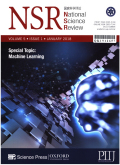- 钛学术文献服务平台 \
- 学术期刊 \
- 科教文艺期刊 \
- 科研管理期刊 \
- 国家科学评论(英文版)期刊 \
null
Mapping intrinsic electromechanical responses at the nanoscale via sequential excitation scanning probe microscopy empowered by deep data
基本信息来源于合作网站,原文需代理用户跳转至来源网站获取
摘要:
Ever-increasing hardware capabilities and computation powers have enabled acquisition and analysis of big scientific data at the nanoscale routine,though much of the data acquired often turn out to be redundant,noisy and/or irrelevant to the problems of interest,and it remains nontrivial to draw clear mechanistic insights from pure data analy tics.In this work,we use scanning probe microscopy (SPM) as an example to demonstrate deep data methodology for nanosciences,transitioning from brute-force analytics such as data mining,correlation analysis and unsupervised classification to informed and/or targeted causative data analttics built on sound physical understanding.Three key ingredients of such deep data analttics are presented.A sequential excitation scanning probe microscopy (SE-SPM) technique is first developed to acquire high-quality,efficient and physically relevant data,which can be easily implemented on any standard atomic force microscope (AFM).Brute-force physical analysis is then carried out using a simple harmonic oscillator (SHO) model,enabling us to derive intrinsic electromechanical coupling of interest.Finally,principal component analysis (PCA) is carried out,which not only speeds up the analysis by four orders of magnitude,but also allows a clear physical interpretation of its modes in combination with SHO analysis.A rough piezoelectric material has been probed using such a strategy,enabling us to map its intrinsic electromechanical properties at the nanoscale with high fidelity,where conventional methods fail.The SE in combination with deep data methodology can be easily adapted for other SPM techniques to probe a wide range of functional phenomena at the nanoscale.

推荐文章
期刊_丙丁烷TDLAS测量系统的吸收峰自动检测
带间级联激光器
调谐半导体激光吸收光谱
雾剂检漏 中红外吸收峰 洛伦兹光谱线型
不同盐度、温度及光照对漂浮浒苔生理生态的影响
浒苔
盐度
温度
光照
生理生态
期刊_联合空间信息的改进低秩稀疏矩阵分解的高光谱异常目标检测
高光谱图像
异常目标检测 低秩稀疏矩阵分解 稀疏矩阵 残差矩阵
内容分析
关键词云
关键词热度
相关文献总数
(/次)
(/年)
文献信息
| 篇名 | Mapping intrinsic electromechanical responses at the nanoscale via sequential excitation scanning probe microscopy empowered by deep data | ||
| 来源期刊 | 国家科学评论(英文版) | 学科 | |
| 关键词 | sequential excitation scanning probe microscopy principal component analysis simple harmonic oscillator model | ||
| 年,卷(期) | 2019,(1) | 所属期刊栏目 | |
| 研究方向 | 页码范围 | 55-63 | |
| 页数 | 9页 | 分类号 | |
| 字数 | 语种 | 英文 | |
| DOI | 10.1093/nsr/nwy096 | ||
五维指标
引文网络
引文网络
二级参考文献 (0)
共引文献 (0)
参考文献 (41)
节点文献
引证文献 (0)
同被引文献 (0)
二级引证文献 (0)
1970(1)
- 参考文献(1)
- 二级参考文献(0)
1987(1)
- 参考文献(1)
- 二级参考文献(0)
1992(1)
- 参考文献(1)
- 二级参考文献(0)
2002(1)
- 参考文献(1)
- 二级参考文献(0)
2003(1)
- 参考文献(1)
- 二级参考文献(0)
2007(2)
- 参考文献(2)
- 二级参考文献(0)
2009(4)
- 参考文献(4)
- 二级参考文献(0)
2010(2)
- 参考文献(2)
- 二级参考文献(0)
2011(2)
- 参考文献(2)
- 二级参考文献(0)
2012(2)
- 参考文献(2)
- 二级参考文献(0)
2013(2)
- 参考文献(2)
- 二级参考文献(0)
2014(2)
- 参考文献(2)
- 二级参考文献(0)
2015(3)
- 参考文献(3)
- 二级参考文献(0)
2016(6)
- 参考文献(6)
- 二级参考文献(0)
2017(7)
- 参考文献(7)
- 二级参考文献(0)
2018(4)
- 参考文献(4)
- 二级参考文献(0)
2019(0)
- 参考文献(0)
- 二级参考文献(0)
- 引证文献(0)
- 二级引证文献(0)
研究主题发展历程
节点文献
sequential excitation
scanning probe microscopy
principal component analysis
simple harmonic oscillator model
研究起点
研究来源
研究分支
研究去脉
引文网络交叉学科
相关学者/机构
期刊影响力
国家科学评论(英文版)
主办单位:
中国科技出版传媒股份有限公司
出版周期:
月刊
ISSN:
2095-5138
CN:
10-1088/N
开本:
大16开
出版地:
北京市
邮发代号:
80-671
创刊时间:
2014
语种:
eng
出版文献量(篇)
773
总下载数(次)
0
总被引数(次)
431
期刊文献
相关文献
推荐文献

 免费查重
免费查重










